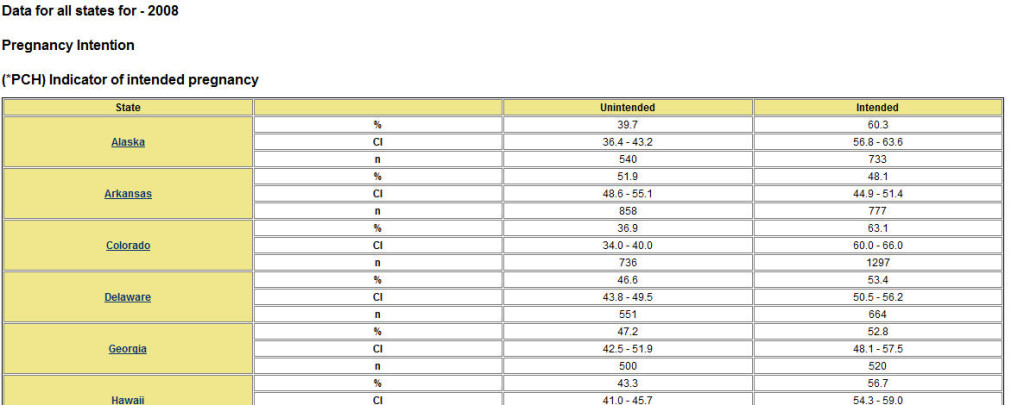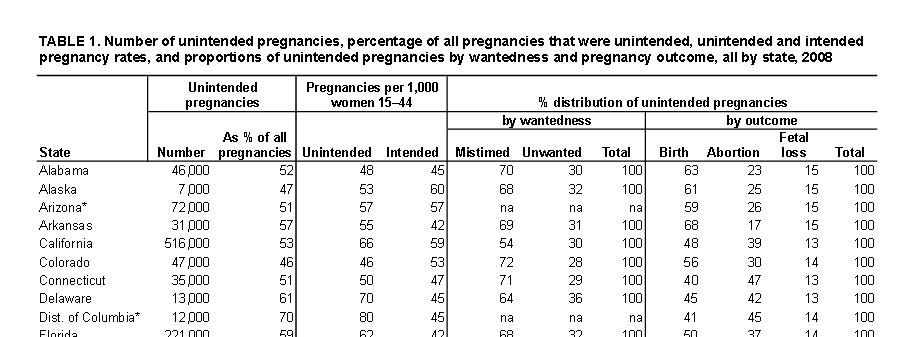Subscribe to Blog via Email
Good Stats Bad Stats
Search Text
June 2025 S M T W T F S 1 2 3 4 5 6 7 8 9 10 11 12 13 14 15 16 17 18 19 20 21 22 23 24 25 26 27 28 29 30 -
Recent Posts
goodstatsbadstats.com
Unintended pregnancies
The Guttmacher Institute released a report this past Monday titled: “Unintended Pregnancy Rates at the State Level: Estimates for 2002, 2004, 2006 and 2008.” After reading the report I was reminded of a former supervisor’s term for statistical research that went too far. He called it “polishing to soles of your shoes.” I wonder if that is what I am seeing in this paper.
The original source of the data used in the report starts with the Pregnancy Risk Assessment Monitoring System or PRAMS which is a surveillance project of the Centers for Disease Control and Prevention (CDC) and state health departments. The authors used the PRAMS data for the states where it was available. The did some modeling work to add in the other states who are not part of the PRAMS system. Then they added additional data or abortions and “fetal loss” to arrive at their measures of unintended pregnancies.
The CDC produces regular measure of counts and percentages of unintended pregnancies. Their measure is based on a single question in the PRAMS survey. That question is: “Thinking back to just before you got pregnant with your new baby, how did you feel about becoming pregnant?” The set of possible answers is somewhat restrictive. The only possible answers are you wanted to get pregnant when you did, sooner than you did, later than you did, or never. Answering never or later is classified as an unintended pregnancy.The research community, including the authors of this paper are well aware of the limitation noting that later may well mean as little as one month or it many mean “when I get married.” or “when I graduate from College and an well established in at job.”
 Under this definition the CDC tells us that in GA for example the unintended pregnancy rate was 47.3 percent in 2008. An abbreviated table is from the CDC is shown at the right. The full table is available here. Other similar tables and tables for additional years can be created form the CDC website.
Under this definition the CDC tells us that in GA for example the unintended pregnancy rate was 47.3 percent in 2008. An abbreviated table is from the CDC is shown at the right. The full table is available here. Other similar tables and tables for additional years can be created form the CDC website.
 The Guttmacher Institute paper added value with the models for the states not available in the CDC system. The second table on the right shows some of the data from the paper for a few states. I do not consider here the quality of those models but note only that modeling to obtain a full set of states is a worthwhile effort. But they go beyond the models to factor in abortions and what they refer to as “fetal loss.” The value of both of these is open to serious questioning. The estimates obtained by the Guttmacher Institute for unintended pregnancies are generally higher than those obtained by the CDC. For example their estimate for GA is 60 percent, much higher than the CDC number of 47.3 percent.
The Guttmacher Institute paper added value with the models for the states not available in the CDC system. The second table on the right shows some of the data from the paper for a few states. I do not consider here the quality of those models but note only that modeling to obtain a full set of states is a worthwhile effort. But they go beyond the models to factor in abortions and what they refer to as “fetal loss.” The value of both of these is open to serious questioning. The estimates obtained by the Guttmacher Institute for unintended pregnancies are generally higher than those obtained by the CDC. For example their estimate for GA is 60 percent, much higher than the CDC number of 47.3 percent.
The main reason for the higher numbers is the count of abortions as they are all counted as unintended pregnancies by the Guttmacher Institute. That they are all unwanted is not an accurate assumptions as abortions are preformed for a number of reasons. Getting data on abortions for unwanted pregnancies alone is not an easy task. Also getting an accurate measure of the number of abortions is also not an easy task. While the Guttmacher Institute conducts survey of abortion providers they have not way of mearsureing abortions due to the use of things like the morning after pill. Some of these methods would be required as true abortions and other are preventative in case a pregnancy occurred where no one knows if it did or did not occur.
Then there is the issue of measures of “fetal loss.” This measure includes miscarriages and the like. Some of these occur in the first weeks of pregnancy and as the authors admit the mothers may not even know that the miscarriage occurred.
So we are left with a new measure, all be it higher, that started out with data where the actual definition of unintended pregnancy is somewhat suspect. To that was added incomplete data on abortions that can only increase the percentages with assumptions that are clearly not correct in all circumstances. Next cases of “fetal loss” were added in based on clearly incomplete data. Somehow I am left with the feeling that I do not know a lot more, but that the soles of my shoes sure do look nice with the new polish.
Posted in Data Quality, Methodolgy Issues